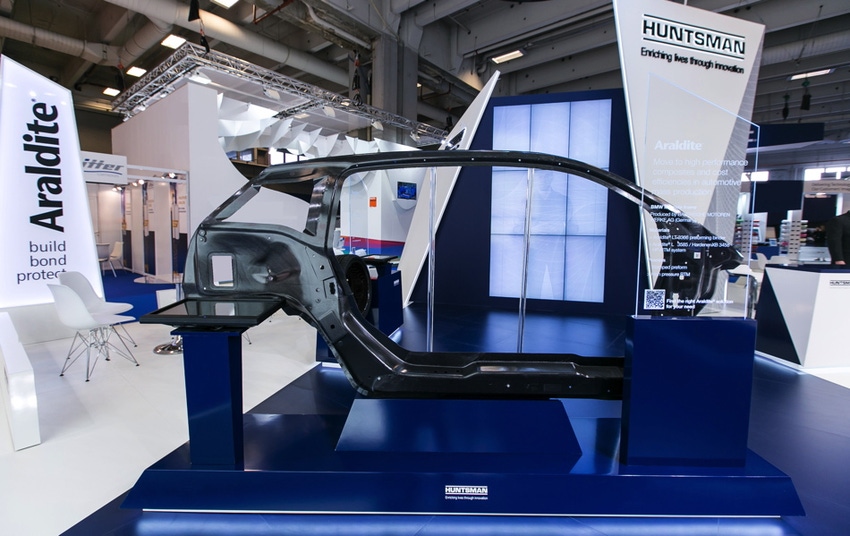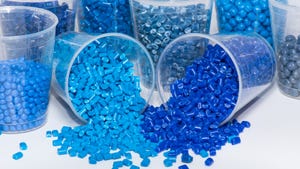In the on-going commitment to reduce weight even further in automotive structures, many OEMs and suppliers are focusing on implementing the best and most cost-effective processing techniques to manufacture mass-produced, epoxy composite vehicle parts. we look at how Huntsman Advanced Materials (Basel, Switzerland) is helping to optimize the latest out-of-autoclave manufacturing techniques, working to match demands for excellent component properties with shorter production cycles in mass production.
October 7, 2014

In the on-going commitment to reduce weight even further in automotive structures, many OEMs and suppliers are focusing on implementing the best and most cost-effective processing techniques to manufacture mass-produced, epoxy composite vehicle parts. we look at how Huntsman Advanced Materials (Basel, Switzerland) is helping to optimize the latest out-of-autoclave manufacturing techniques, working to match demands for excellent component properties with shorter production cycles in mass production.
Huntsman Advanced Materials has a long heritage of pioneering technologically advanced epoxy systems. In the automotive sector, the company's legacy of technical innovation and epoxy composite applications spans from the super car market to structural applications on luxury marques and more recently, mass-produced vehicle parts.
Evolving processes
Standard, low pressure resin transfer molding (RTM) has been used to meet the quality and functional standards set for highly complex parts on performance cars for many years. However, in mass vehicle production, where affordable processing solutions and the delivery of parts in minutes with minimal waste are a must, this technique is not suitable.
|
Huntsman's materials are used to produce the side frame and other composite parts of the BMw i3 passenger cell in volume production. |
Complementary technologies
Meeting demands for reduced production cycles in high volume automotive manufacturing, Huntsman continues to develop epoxy resin systems for high pressure RTM (HP-RTM) and wet compression molding. These two technologies complement each other well, with HP-RTM enabling fast production for highly complex parts and wet compression molding facilitating even faster production, but for low complexity parts.
HP-RTM is a relatively new concept as and an appropriate processing system for manufacturing lightweight high-performance parts. By comparison to low pressure RTM, which is characterized by long process times due to the number of manual processes involved, HP-RTM scores highly on the level of automation provided. Accelerated chemical reactions and extremely short cycle times are made possible due to the high pressure injection, mixing and use of highly reactive epoxy systems that HP-RTM facilitates.
Another process enabling reduced parts production costs is the compression molding process, which is ideal for less complex components. The faster production cycles it offers, coupled with a lower investment cost than HP-RTM, results in significant cost reductions for low complexity structural parts.
Relatively lower tooling costs and capital investment are associated with compression molding. Preforming is not mandatory due to the vertical impregnation of the epoxy system, which takes place outside the mold during the 'liquid lay down' process. This eliminates the need for the injection process, allowing the mold to operate at a higher temperature for faster curing. The use of simple molds for simple parts also contributes to tooling cost reductions.
Moving from classical compression molding to the latest compression molding processes where vacuum assisted options are available, manufacturers can benefit from void free parts produced to the highest quality, alongside even greater design flexibility and less material waste.
Fast and flexible epoxy systems
Huntsman is the first company to have developed epoxy resin systems that are qualified for mass production of structural parts. These systems are proven in offering advanced properties and significant production time savings for out-of-autoclave processes such as RTM and compression molding.
Supporting the development of fast and flexible epoxy systems with superior properties that meet the sector's demands for continuous improvements, within its state-of-the-art laboratories, the company uses computer simulation technologies to speed-up identification of the best processing parameters. One of Huntsman's latest epoxy systems, Araldite LY 3585 / Aradur 3475 allows HP-RTM parts to be made within four minutes, and enables further reductions by compression molding, at just two minutes. With HP-RTM, for example, this includes preform set, injection, curing and de-molding and equates to a 40% part production time reduction when compared with first generation HP-RTM.
Optimizing automotive composites
Over the past four years, working with global performance and mass-market vehicle manufacturers, Huntsman's involvement in various innovative projects has seen the industry make considerable strides in optimizing automotive composites using the latest process techniques. For example, Huntsman has a long and successful history with the BMW Group, currently involving the supply of an Araldite binder and epoxy for manufacturing the composite parts on the BMW i3 and i8 in volume production.
Prior to this, Huntsman also provided an epoxy resin system (Araldite XB 3523 / XB 3458) used to develop roof parts for the BMW M3 - the first carbon fiber reinforced part to be produced on high-pressure equipment for the series application of carbon look parts. Araldite XB 3523 / XB 3458 offers low shrinkage during curing to enable the production of high surface quality components that meet the automotive A-Class surface standard. The process also significantly reduces finishing and other preparatory work before painting. These advantages demonstrate how epoxy systems for out-of-autoclave processes can help to reduce cost, deliver excellent properties and increase the design options in carbon composites.
Leading in auto composites series-production
In the five years since BMW decided to manufacture an all-electric vehicle with a composite passenger cell, the BMW i3 has now become the first series-produced car to make extensive use of composites in primary structural components.
BMW describes the architecture of the BMW i3 as having two main elements. The aluminum Drive module, which incorporates the powertrain, chassis, battery and structural crash functions - and the Life module (or passenger cell), made from carbon fiber-reinforced plastic (CFRP). The LifeDrive concept and CFRP usage allows production time to be cut by half compared to those required for an equivalent car built along conventional lines. The process is less investment-intensive as the high costs needed for a conventional press shop and paintshop are no longer an issue and the Life and Drive modules can be manufactured alongside one another.
This is all supported by what can best be described as the largest and most sustainable composites material and fabrication supply chain ever established for a production vehicle. For example, once the PAN precursor for the carbon fiber is manufactured in Otake, Japan by MRC SGL Precursor (a joint venture of Mitsubishi Rayom and SGL Group), it is transported to Moses Lake, Washington to benefit from the relatively inexpensive hydroelectric power provided by the BMW dedicated facility run by SGL Automotive Carbon Fibers (SGL ACF). From here, the carbon fiber roving is sent to another SGL ACF facility in Wackersdorf, Germany, where different forms of fabric, including unidirectional tapes and multiaxial weaves, are produced and prepared for RTM.
The high-pressure RTM parts for the BMW i3 passenger cell are manufactured at two of BMW's facilities in Leipzig and Landshut, Germany, which use the same processes and equipment. Within these facilities, Huntsman's materials are used to produce the side frame and other composite parts of the i3 passenger cell in volume. Firstly, Araldite LT 3366 is used as a binder to help maintain correct fiber alignment and geometry during the automated manipulation and positioning of the dry preform in the mold. Araldite LY 3585 / Hardener XB 3458, an epoxy RTM system, is then injected at high pressure into the mold. Its low viscosity is essential to the entire process, from the dosing and mixing right through to implementation and good fiber wet-out in the mold.
Providing good thermo-mechanical performance, including a high elongation at break, this Araldite RTM system is particularly beneficial for automotive structural parts and for meeting crash test criteria. With its ability to cure in just five minutes at 100°C, Araldite LY 3585 / Hardener XB 3458 allows BMW to effectively utilize HP-RTM and meet its rate production requirements in a quick and cost-effective way. This system is also well suited to compression molding and the production of low complexity structural parts.
The use of carbon composites on the scale required for the mass production of the BMW i models is without parallel in the automotive industry. Here, Araldite LY 3585 / Hardener XB 3458 enables large composite components for consumer vehicles to be made under mass-market conditions for the first time.
Looking to the future
Huntsman recently established four new Centres of Excellence, developing new technology platforms that support the company's regional development teams. One of these centers, the Centre of Excellence for Composites, is building up simulation capabilities to provide consultancy on automotive composites projects. The simulation technology developed supports Huntsman's customers in helping them to select the most ideal product and process parameters, supporting the best tooling geometries in order to ensure the most efficient processes are in place.
Demands for even faster production rates, coupled with requirements for higher mechanical properties and greater design freedom, show how the market for automotive composites has developed into a creative and fast-moving sector. In this context, the Centre of Excellence for Composites is set to play a pivotal role in actively supporting Huntsman's on-going investigations into faster curing epoxies.
Klaus Ritter, Head of the Centre of Excellence for Composites, Huntsman Advanced Materials
About the Author(s)
You May Also Like



